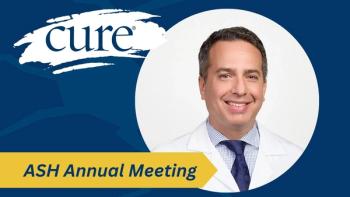
Understanding the Basics of Myeloproliferative Neoplasms

Transcript:
Kristie L. Kahl: Can you explain how rare MPNs are?
Dr. Ruben Mesa: So, as I like to explain in my patients, MPNS are not rare but they're not common, you know, so they comprise about 300 thousand to 350 thousand individuals affected with these diseases across the United States, between myelofibrosis roughly about 20 plus thousand; and about a hundred and fifty thousand or so patients with essential thrombocythemia; and 150,000 or so with polycythemia vera. There certainly are some diseases that are much more rare, but clearly there are diseases that are much more common.
Kristie L. Kahl: How do you think the rarity of these diseases affects awareness around the disease?
Dr. Ruben Mesa: Without question it still is a group of diseases that largely are not on the public consciousness. It is challenging have a disease that is not being talked about on “Good Morning America” or “The View” or other kind of widely held platforms. Most patients when they're diagnosed, it's really the first time they've heard about these diseases. And more importantly, their support structure, their friends, their family, their employers aren't very familiar with them and that frequently puts a patient in a bit of a tough spot having to both share that they have this diagnosis but also kind of explain what it is, how severe it is, etc.
Kristie L. Kahl: Does this also highlight the fact that there's a need for more research in this disease state?
Dr. Ruben Mesa: I think without question. This is a group of diseases that is linked with other diseases that in aggregate really does make it a much more common group of problems. So the MPNs are a type of a chronic leukemia, so they're relatives of other diseases like myelodysplastic syndrome, chronic myeloid leukemia, acute myeloid leukemia — and in aggregate these are diseases that are not uncommon and they're particularly common as we get older. So, as our population is greying, the prevalence of these diseases is increasing.
So the understanding of why people develop these diseases, why they're linked with aging, how we screen for them, how we prevent them, how we treat them is incredibly important. Advances in research in MPN patients might help many other patients with other types of blood diseases and vice versa.
Kristie L. Kahl: In simple terms, can you discuss the different types of MPNS and how they're different from one another?
Dr. Ruben Mesa: So, first there's essential thrombocythemia. These are diseases, in particular, where patients have an elevation in their platelet count. They can have an elevation in the white blood cell count, but the elevation in the platelet count is really the hallmark of the disease. We believe the disease itself really originates in the early cells from the bone marrow.
Second is the disease of polycythemia vera. This is really characterized by an increase in the number of red blood cells, but there can also be an increase in the number of platelets or white blood cells and similarly a stem cell disease of the bone marrow.
Finally, there is the disease of myelofibrosis. Now this tends to be a more advanced disease in individuals that had progressed from previously having essential thrombocythemia, or what we call ET, or polycythemia vera, what we call PV. So, people can progress from one of those into myelofibrosis or people might have myelofibrosis as really the initial diagnosis that they have. Patients with myelofibrosis tend to have an enlarged spleen, they have significant scarring in the bone marrow, they actually can tend to have low blood counts.
Kristie L. Kahl: What are some signs and symptoms that individuals should be aware of that could be a result of an MPN?
Dr. Ruben Mesa: First, individuals can have changes in their blood counts. With ET, that can be to higher platelets or white cells. With PV, any of the cells can be increased. With myelofibrosis, some are increased or decreased.
Second, individuals can have enlargement of the spleen, an organ that's a filter for the blood under the ribcage on the left side.
Third, all of these diseases somewhat do predispose patients to developing a blood clot or bleeding and sometimes that's how we find the disease: An individual has an unexpected blood clot in the legs or lungs or other area or unexpected bleeding, they have blood counts taken and they see this abnormality.
And finally, patients can have various symptoms from the enlarged spleen, discomfort, filling up early when they eat, inadvertent weight loss, night sweats, fevers, and most importantly, fatigue across all of those diseases. Even itching can be a significant difficulty.
Kristie L. Kahl: If somebody's experiencing any of those signs or symptoms what do you think their first step should be?
Dr. Ruben Mesa: Their first step certainly should be to visit with their primary care doctor. These might be a sign of having an MPN, but of course, it might be a sign of other things. With any one of those symptoms that I've described, there's multiple potential causes but an MPN is an important thing for us to be mindful of. So, for example, although we watch for enlargement of the spleen in patients with MPNs, actually probably the most common reason for enlargement of the spleen in the country would be someone with an infection or someone with mononucleosis. So, every one of these is a possibility. But there is no one symptom that says, “Aha, this is automatically an MPN.”
Kristie L. Kahl: To bring it all together with the basics of the disease, what would you say is the most important thing for a patient who's diagnosed with an MPN to know about?
Dr. Ruben Mesa: I think the most important thing is for them to really understand their disease and have that conversation with their doctor. There's a lot of great information out there from CURE magazine, from the Leukemia Lymphoma Society, from the MPN Education Foundation, from the MPN Research Foundation. There's a lot of very high-quality educational materials out there. Which of those materials are very specific and accurate for that individual patient? That really needs to be kind of aligned with their doctor.
I have seen patients that have read very good, high quality materials, but materials that really were not directly relevant for their stage or type of disease. So I think kind of a curated education around your disease is very important. These are chronic diseases. So understanding them, understanding what we watch for, if you're on therapy, understanding why you're on therapy, what do we watch for, why that therapy is very important. Care of an important partnership between the patient and their physician.
Transcription edited for clarity.




